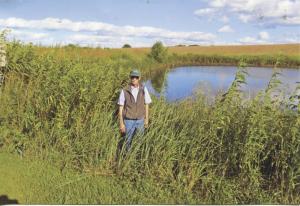He Farms The Prairie
 ✖  |
Carl Kurtz was born and raised in the middle of Iowa’s tallgrass prairie. Over the years, that sea of grass has been crowded out by corn, soybeans and other cash crops. Kurtz has restored much of the prairie acreage on his farm. He has also helped other farmers restore or reconstruct prairie acreages to reduce soil erosion and, in some cases, to generate extra income.
Kurtz has built a business showcasing the economic and environmental benefits of growing prairie grass. He and his wife, Linda, offer prairie tours for farmers, gardeners and researchers. They enjoy the kaleidoscope of color in prairie flowers ranging from blazing star to purple coneflower. Researchers compare notes with Kurtz’s data gathered from 30 years of prairie study. Conservationists check the prairie mat’s erosion control. Farmers come to learn Kurtz’s system for establishing prairie plantings ranging from wildlife preserves to filter strips.
“Reconstructing prairie involves starting a prairie from scratch on a bare crop field,” he says. “Restoration has more to do with reclaiming degraded or worn out grass stands. Both systems require special management practices and some patience. Done right, a well-established prairie will last a lifetime.”
Kurtz literally wrote the book on prairie establishment. “A Practical Guide to Prairie Reconstruction”, now in its second edition, as a reference manual for farmers, agronomists, and conservationists. The volume covers aspects of prairie care including seeding, fertilization, burning, and harvesting.
He harvests more than 100 acres of his own and rented prairie fields. “Grass and flower seeds are usually dry enough to combine about the time soybeans are ready for harvest,” he says. “Bagging and storing seeds takes extra time and effort.”
County, municipal, and corporate groups plus many individual farmers are switching to prairie grass seeds for CRP, waterways, and corporate landscapes. They buy various prairie seeds and use Kurtz’s step-by-step instructions for establishing prairie.
Kurtz illustrates his workshops and seminars with photos he’s taken during many years of working with prairie plants. He offers researchers excellent photos online from his extensive library. He also sells photos online for use in classrooms, presentations, and in publications.
Kurtz conducts his “everything prairie” business from his St. Anthony, Iowa home. His low-overhead farming operation includes a remodeled seeder, cultipacker, mower, and 3 used tractors, plus a lot of hand tools.
“You don’t need expensive equipment for successful prairie grass farming,” he says. “You do need to watch cultural details and have a desire to enjoy the beauty and benefits of prairie plantings.”
Contact: FARM SHOW Followup, Carl Kurtz, 1562 Binford Ave., St. Anthony, Iowa 50239 (ph 515 487-8364).

Click here to view page story appeared in
Click here to read entire issue
He Farms The Prairie CROPS Miscellaneous Carl Kurtz was born and raised in the middle of Iowa’s tallgrass prairie Over the years that sea of grass has been crowded out by corn soybeans and other cash crops Kurtz has restored much of the prairie acreage on his farm He has also helped other farmers restore or reconstruct prairie acreages to reduce soil erosion and in some cases to generate extra income Kurtz has built a business showcasing the economic and environmental benefits of growing prairie grass He and his wife Linda offer prairie tours for farmers gardeners and researchers They enjoy the kaleidoscope of color in prairie flowers ranging from blazing star to purple coneflower Researchers compare notes with Kurtz’s data gathered from 30 years of prairie study Conservationists check the prairie mat’s erosion control Farmers come to learn Kurtz’s system for establishing prairie plantings ranging from wildlife preserves to filter strips “Reconstructing prairie involves starting a prairie from scratch on a bare crop field ” he says “Restoration has more to do with reclaiming degraded or worn out grass stands Both systems require special management practices and some patience Done right a well-established prairie will last a lifetime ” Kurtz literally wrote the book on prairie establishment “A Practical Guide to Prairie Reconstruction” now in its second edition as a reference manual for farmers agronomists and conservationists The volume covers aspects of prairie care including seeding fertilization burning and harvesting He harvests more than 100 acres of his own and rented prairie fields “Grass and flower seeds are usually dry enough to combine about the time soybeans are ready for harvest ” he says “Bagging and storing seeds takes extra time and effort ” County municipal and corporate groups plus many individual farmers are switching to prairie grass seeds for CRP waterways and corporate landscapes They buy various prairie seeds and use Kurtz’s step-by-step instructions for establishing prairie Kurtz illustrates his workshops and seminars with photos he’s taken during many years of working with prairie plants He offers researchers excellent photos online from his extensive library He also sells photos online for use in classrooms presentations and in publications Kurtz conducts his “everything prairie” business from his St Anthony Iowa home His low-overhead farming operation includes a remodeled seeder cultipacker mower and 3 used tractors plus a lot of hand tools “You don’t need expensive equipment for successful prairie grass farming ” he says “You do need to watch cultural details and have a desire to enjoy the beauty and benefits of prairie plantings ” Contact: FARM SHOW Followup Carl Kurtz 1562 Binford Ave St Anthony Iowa 50239 ph 515 487-8364
To read the rest of this story, download this issue below or click
here to register with your account number.







